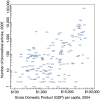Attention to local health burden and the global disparity of health research
- PMID: 24691431
- PMCID: PMC3972174
- DOI: 10.1371/journal.pone.0090147
Attention to local health burden and the global disparity of health research
Abstract
Most studies on global health inequality consider unequal health care and socio-economic conditions but neglect inequality in the production of health knowledge relevant to addressing disease burden. We demonstrate this inequality and identify likely causes. Using disability-adjusted life years (DALYs) for 111 prominent medical conditions, assessed globally and nationally by the World Health Organization, we linked DALYs with MEDLINE articles for each condition to assess the influence of DALY-based global disease burden, compared to the global market for treatment, on the production of relevant MEDLINE articles, systematic reviews, clinical trials and research using animal models vs. humans. We then explored how DALYs, wealth, and the production of research within countries correlate with this global pattern. We show that global DALYs for each condition had a small, significant negative relationship with the production of each type of MEDLINE articles for that condition. Local processes of health research appear to be behind this. Clinical trials and animal studies but not systematic reviews produced within countries were strongly guided by local DALYs. More and less developed countries had very different disease profiles and rich countries publish much more than poor countries. Accordingly, conditions common to developed countries garnered more clinical research than those common to less developed countries. Many of the health needs in less developed countries do not attract attention among developed country researchers who produce the vast majority of global health knowledge--including clinical trials--in response to their own local needs. This raises concern about the amount of knowledge relevant to poor populations deficient in their own research infrastructure. We recommend measures to address this critical dimension of global health inequality.
Conflict of interest statement
Figures



References
-
- Henschke UK, Leffall LD Jr, Mason CH, Reinhold AW, Schneider RL, et al. (1973) Alarming increase of the cancer mortality in the U.S. black population (1950–1967). Cancer 31: 763–768. - PubMed
-
- Medicine Io (2003) Unequal Treatment: Confronting Racial and Ethnic Disparities in Health care. Washington, DC: National Academy of Sciences.
-
- Marmot M (2005) Social determinants of health inequalities. Lancet 365: 1099–1104. - PubMed
-
- Lurie N (2005) Health disparities–less talk, more action. The New England Journal of Medicine 353: 727–729. - PubMed
Publication types
MeSH terms
LinkOut - more resources
Full Text Sources
Other Literature Sources
Medical

